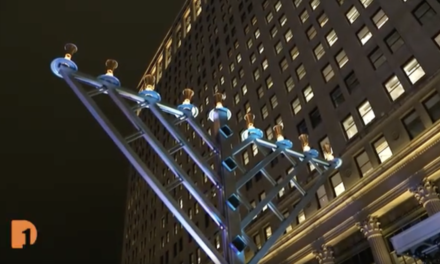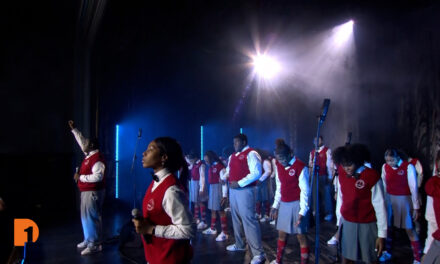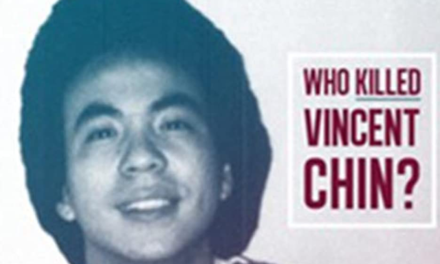It was the summer of 1949 when Detroit began ushering in a new wave of urban renewal, and Detroit’s Black Bottom neighborhood quickly became the target for the bulk of the city’s urban redevelopment. The Plowshares Theatre Company‘s new musical “Hastings Street” depicts the life of one African American family, the Carsons, in flux as the city unravels a host of changes of its own. The musical runs through July 31, 2022 at the Music Hall Center for the Performing Arts.
RELATED: Plowshares Theatre Presents ‘Hastings Street’ Musical About Detroit’s Black Bottom Neighborhood
RELATED: Michigan Historical Marker Designated to Detroit’s Historic Black Bottom Neighborhood
Before the world premiere of the musical, “American Black Journal” producer Marcus Green takes viewers behind the scenes to a rehearsal to see how the musical came together. Plus, Green talks with the musical’s co-creators, jazz trumpeter/composer Kris Johnson, actor/singer John Sloan III, and Plowshares Theatre Artistic Director Gary Anderson about the making of the musical, the Detroit history it represents, and the message viewers can take away from the performance.
Full Transcript:
John Sloan III, Co-Creator, “Hastings Street”: For Hastings Street, we knew there was going to be set very specifically in ’49 and ’50 in Detroit, in Black Bottom, in Paradise Valley. And so what does that do then to the music that is inherent to that time period? If somebody is walking into a bar in Black Bottom in 1950, what are they going to be hearing? Right.
And so there’s that aspect to it. And there’s also, I think, some music that isn’t necessarily anachronistic to the time period, but that draws a similar contrast. That is really speaking to, well, where is a person where the main characters, Renita has a song called Towers. What is going through her head? What is she feeling at this moment? And how do we express that through music?
Kris Johnson, Co-Creator, “Hastings Street”: I think right now we have this opportunity to be on a major stage and what I consider to be a very important city from an artistic and historic standpoint. And to be able to be working with Plowshares Theater and the history that they’ve really carved out for themselves here in the city of Detroit is really significant.
Kris Johnson: Gary Anderson has been a longtime collaborator of mine, and I’m really proud to be working with him. I’m really proud of what he’s put together in both commissioning us to put this piece together, as well as this production that we’re about to see.
Gary Anderson, Producing Artistic Director Plowshares Theatre Company: We were all working on another project that was supposed to be Detroit related, that wasn’t really Detroit related, and it fell apart. And I think it fell apart for a legitimate reason. It wasn’t going to focus the attention on something that was going to celebrate Detroit.
Gary Anderson: And so I decided that working with them has shown me that they had some talent and what the best thing to do is to seek some funding so that we could get them commissioned to create a work that was going to focus on and on really an untold story in Detroit, and that is the conditions that occurred during the raising of the Black Bottom.
John Sloan III: For me, having family constantly talking about Black Bottom. My grandmother used to tell stories about how they would take pennies and coins and put them on or tack them to the bottom of their shoes and go out and dance in the streets, standing outside, listening to music. And that neighborhood doesn’t exist anymore.
The city that we grew up in was very different from the city that our grandparents and aunts and uncles and family grew up in. And when there’s a difference, I think, between hearing your family talk about a story and then actually doing research and like investigating that story more thoroughly. And for me, I think it was the idea that this street that could have had however many businesses, stores, shops, homes, families is now a couple blocks. You know what I’m saying? Like that to me was a great microcosm in understanding what happened to a whole community.
Kris Johnson: And I think even being in a room like this where we’re able to see so much history and so much detail that has been preserved. But then we’re talking about an area where it’s really the lack of having access to that resource. Having access to that even visual reference of what this would have looked like and what this would have been had it still existed now, is a large part of what is informed this piece.
Because now we’re really thinking about what could have this legacy have been if this had continued. How would it have shaped the music, how would it have shaped the culture, the infrastructure of business? How would it have really changed the Black community in the city of Detroit had those neighborhoods not been destroyed?
Gary Anderson: Hastings Street was a cultural and entertainment hub for Black folks. Everything that you think about when you talk about Broadway or you talk about Woodward Avenue here, that was Hastings Street.
John Sloan III: The stories that happened in Detroit are just as valid as the stories that happened in New York. The people that live in this city, that have lived in the city, in this community are just as influential. If not, if I dare say so myself, more so sometimes when you start talking about the history of manufacturing sectors and like the birth of the middle class and everything that came out of this city and this geography and these people and that their stories deserve to be told, but their stories deserve to be cherished.
Kris Johnson: I want people to walk away feeling proud of the history of our city and also feeling proud of the musical influence that African-Americans have had on the world of music. Because we have everything represented here. Every piece you could ask for, whether we’re talking about jazz, whether we’re talking about blues. Or even talking about the influence that we’ve had on the music referred to as classical music or even the influence that it was had on the history of musical theater. If you really think about it, Black American music has shaped the face of what popular music is across the world.
Gary Anderson: We also need to look at that one of the elements of this play talks about is coming together. The importance of people of a community unifying to work on large challenges. I get choked up about that because it means a lot. We, Plowshares has instituted this policy, what we call Harambee. It’s a Kenyan principle.
In Swahili, Harambee means “all pull together,” which shows you the importance of nobody does anything; nobody does anything alone. And, others have to be invested and see the benefit of being engaged. And one of the messages of this story is that even though this community was fractured and displaced, the key to us moving things forward in Detroit is by coming together, having a common interest and a common goal.
Gary Anderson: And I think that’s the main thing that I could get across. The idea of this story being used to convey that message to this, to the people who see it. Hopefully. Hopefully. Might spark some people to see that as a solution for our current situation.
Stay Connected:
Subscribe to Detroit Public Television’s YouTube Channel & Don’t miss American Black Journal on Tuesday at 7:30 p.m and Sunday at 9:30 a.m. on Detroit Public TV, WTVS-Channel 56.
Catch the daily conversations on our website, Facebook, Twitter and Instagram @amblackjournal.
View Past Episodes >
Watch American Black Journal on Tuesday at 7:30 p.m. and Sunday at 9:30 a.m. on Detroit Public TV, WTVS-Channel 56.




